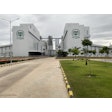
3 new outbreaks have been officially registered in in South Africa, while local media in Nigeria are also reporting new cases.
Three new outbreaks of African swine fever (ASF) have been officially registered in South Africa. According to the latest reports to the World Organisation for Animal Health (OIE), these involved two farms in Gauteng and one village herd in Western Cape.
Outbreaks in Gauteng occurred in mid-May, and affected premises with 60 and 35 pigs. At the first location near Midvaal in the Sedibeng district, 31 of the pigs died, and there were four mortalities at the second farm near Randfontein in the West Rang district.
These outbreaks bring the total for this series — which started in the province of Mpumalanga in April 2019 — to 53. Almost 39,000 pigs have been directly impacted by the disease.
A second series of group of outbreaks has occurred in Western Cape. The latest outbreaks there — in a village herd — brings the outbreak total to 19 and the number of animal directly impacted to 1,123. Around 50 of the 300 pigs died at a village in the municipality of Saldanha Bay in the middle of April. Fate of the remaining animals is not reported.
So far affecting only Western Cape, the first outbreak in this series was in February. However, the ASF virus had been detected only the previous month.
Of the 19 outbreaks in the province so far, 17 were in the Cape Town area. In March, there was an isolated outbreak near Mossel Bay, which is in the province’s easternmost Garden Route district. Saldanha Bay is located in the West Coast region to the north of Cape Town.
ASF confirmed at Ivory Coast farm
During the third week of April, 30 pigs died at a farm near Bondoukou, the capital of the Zanzan district, according to the latest official report to the OIE. Investigations revealed the presence of the ASF virus, after which the remaining 69 pigs were culled.
Source of the infection was attributed to the introduction of new animals. Located in the east of this West African country, Zanzan shares an international frontier with Ghana.
According to the OIE report, ASF was last detected in the country in June 2020.
Previously, after a reported absence of less than one year, ASF returned to Ivory Coast in July 2019. Three outbreaks were confirmed in the Montagnes district, which is in the west of the country, and borders Liberia and Guinea. Around 12,000 pigs were directly impacted by those initial outbreaks.
Last week, the Minister of Animal and Fishery Resources promised support for the country’s pork sector. According to the Ivory Coast press agency, he made this undertaking after hearing about the decline in pig production and slaughtering, and a lack of modern equipment. Presence of ASF in the country was not mentioned in the report.
New outbreaks in south Nigerian state
So far, 311 pigs have died as the result of an ASF outbreak in the state of Ebonyi, reports Leadership of Nigeria. This total includes 250 animals at one farm, as well as two outbreaks among smaller herds.
Owner of the farm, Chief Igwe Edeze said sales of pigs and visitors to pig premises have been banned in Ebonyi. Aim of these measures is to prevent the further spread of the disease, he said.
In February 2020, ASF outbreaks were reported in three states — Lagos, Abia and Ogun. At one cooperative, losses of pigs reportedly exceeded 74,000. Nationwide culls have been put at as many as 1 million.
In August 2020, one of the most recent reports to the OIE indicated the highest levels of morbidity and mortality from ASF in Lagos and Abia. Detailed reporting of the situation over recent months has been scarce.
Study reveals ‘huge’ ASF losses in Cameroon
ASF first reached the central-western African state in 1982, and led to the loss of 80% of the country’s pigs. This is among the key findings of a review of the ASF situation in the Republic of Cameroon published in the journal Pathogens last month.
Working with researchers from Belgium, scientists from the University of Buea isolated only viruses from serogroup I and genotype I in the main pig-producing regions. Because of the absence of other virus carriers — such as soft ticks and warthogs — researchers concluded that domestic pigs and/or humans are most likely to be responsible for the frequent return of ASF to the country.
The authors conclude that ASF is endemic in Cameroon.
Economic losses reached more than US$5.2 million in 1982. Five years later, they had amounted to US$25.2 million. These prompted the national government to implement strict disease control measures five of the worst-affected regions. However, numerous outbreaks of ASF since that time have crippled the nation’s pig production, according to the authors.
A further ASF wave hit the north of the country in 2011, leading to the loss of an estimated 100,000 pigs. Veterinary services blamed poor biosecurity for the spread. Many pig farmers went out of business.
Since 2015, the authorities have introduced stricter sanitary measures across the regions. These were applied according to a risk assessment based on the experiences of the 2010 outbreaks. With no cases reported since that time, the northern regions are considered to be low risk. A zone of the highest risk covers the central and coastal regions, while other areas are considered to be at moderate risk of ASF.
View our continuing coverage of the global African swine fever situation.

















